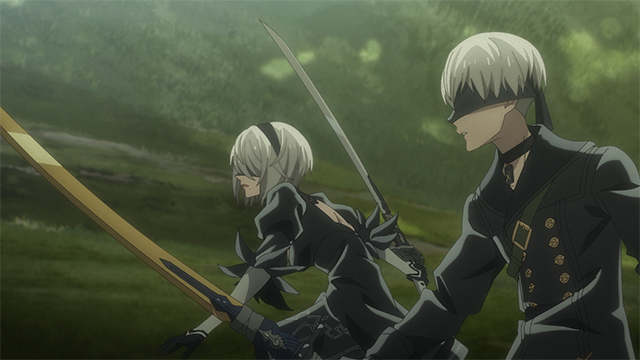#A Case Study of the Female Gaze in More Than a Married Couple But Less than Lovers

Table of Contents
“A Case Study of the Female Gaze in More Than a Married Couple But Less than Lovers”
The male gaze is so common in modern anime that, in many ways, it has become the default gaze. In an industry where the decision makers believe the majority of anime consumers are straight cis men, the products released offer what they think their target audiences want: gratuitous shots of girls’ asses, scenes of bouncing boobs that defy gravity, and convenient setups for white liquids to splash on girls’ faces with their mouths open, tongues out, and eyes sparkling. These are just a few examples of anime scenes that have become commonplace regardless of genre — so commonplace that, after years of feeling disgust, I have grown exasperated at most and generally resigned to the persistence of the male gaze. Female characters are always framed as a conquest, with physical goodies as the ultimate prize.
More than a Married Couple but Less than Lovers is formed around the male gaze since the first episode, but, unexpectedly, it features a single episode framed entirely through the female gaze in a stunning show of visuals and storytelling. While most people still think the “female gaze” is simply the male gaze but flipped for the opposite gender, I want to use episode 7 of More than a Married Couple as a case study to explain exactly what the female gaze is truly about. Thick muscles, abs, and tall, shirtless men can be alluring, but that’s not what defines the female gaze.
Officially, the definition of the “female gaze” is the representation of women characters as having agency. However, like any form of writing, how the agency is portrayed matters more. When examining the gaze of the story, three perspectives are analyzed: the writer’s, the characters’ within the story, and the spectator’s. As a result, any person regardless of gender can write a story containing the female gaze.

One of the easiest examples of the female gaze from an action anime that comes to mind is Jujutsu Kaisen written by Gege Akutami-sensei. His female characters are all written with goals, flaws, and strengths, and he aptly portrays them alongside his intent. Their fight sequences are given equal importance with blood drawn just as devastatingly as the boys, and every one of them is capable of fighting individual battles without the help of others. Any scene that features them always shows them in particular stances and angles to emphasize their individual fighting strengths rather than the typical anime assets. When not in battle, the scenes instead feature their faces, oftentimes with scars, with special detail to their emotional expressions. When viewers watch Jujutsu Kaisen and choose their favorite female characters, they often pick them for their individual talents, fighting abilities, or personality quirks. The writer’s, characters’, and spectators’ perspectives all align in understanding the characters’ agencies, thus conveying the female gaze.
More than a Married Couple, on the other end, begins drenched in the male gaze in all three perspectives. Even ignoring the usual improbable boob mechanics, the male gaze reaches into the depths of the themes and story. Akari, the female protagonist and the male lead’s love interest, is often referred to in the series as a gyaru — a fashion subculture that has since transformed to describe a type of woman who dresses to show more skin, dyes her hair, and is flirtatious and proud of her sexual history. Using fashion as a way to rebel against societal norms, gyaru today are still treated disparagingly in Japan. Unseen Japan has written articles about their treatment, including a gyaru high school girl who was physically separated from her classmates.

Gyaru are often supporting characters in anime, known for being loud and pushing physical boundaries far too often. Akari is my first encounter with a gyaru main protagonist in anime, and the story has a lot to work with when it comes to this type of character. From the get-go, she seems exactly as gyaru are described. She’s comfortable showing more skin, she loves to flirt, and she scoffs at the idea that girls aren’t allowed to chase after guys or are somehow worth less if they have more of a sexual/dating history. When she gets paired up with Jiro, an awkward gamer virgin who has more than a few judgmental thoughts about gyaru and desperately wants a girlfriend, for mandatory married-life-practice for school, trouble immediately brews.
The premise is interesting simply because of what real life has shown: gyaru are shunned for their sexual freedom. What happens when a boy whose only desire is to be with a girl gets paired with one who supposedly gets around? Will Jiro berate Akari for her behavior? Will his preconceived notion of gyaru change as he gets to know her more? How will it change him as a person?
The anime answers none of these questions. Instead, it opts for the more conventional route: Akari, for all her bravado of showing skin and being flirty, is actually a virgin with no sexual experience, who becomes awkward, embarrassed, and helpless the second her sexual teasing of Jiro goes a bit too far, and he starts to reciprocate. Jiro’s only change is “learning” that gyaru girls are secretly all self-conscious girls who use their supposed sexual freedom as a bravado and really just desire men to take care of them, be gentle towards them, and ultimately take the lead in any sexual encounters. In his own words, he realized she can be “cute.”

That story route then translates into the actual visuals: Akari’s pushed-up boobs that look like mountains when she curls up, only to mysteriously become flatter in other scenes. Her facial expression of helplessness with which she gazes upon Jiro with pleading eyes and a slightly open mouth. The sexy swimsuit she bought for Jiro’s viewing pleasure that barely covers her breasts aside from the nipples, for censorship’s sake. And of course, the sex noises she makes when she’s actually screeching in fear over a spider.
She’s one of the two main leads of the story, yet even scenes that are focused on her without Jiro’s horny filter often focus on her tiny waist, ginormous breasts, and erotic face. In a country in which girls who are called gyaru are shamed for their sexual freedom and fashion choices, Akari is turned into a conquest for the male protagonist. Won over by his supposed dogged humbleness and awkwardness, she becomes more conscious of how much skin she shows to everyone else so only he is privy to seeing her body.
Then episode 7 comes, and for a single episode, Akari becomes a character with insecurities and feelings rather than solely Jiro’s romantic interest.

Part of the series’ conflict is that both Jiro and Akari have crushes on other characters despite their obvious growing affection for each other. Akari likes Tenjin, one of the most popular boys in school, known for his princely look and attitude. Jiro likes his childhood best friend, but because of a misunderstanding in the past, he doesn’t think she likes him back. Akari has been steadily working toward confessing to Tenjin, dropping him hints by flirting with him, preparing food for him, and more. However, despite her determined progress, Akari also finds herself increasingly scared of the idea of confessing and getting rejected, so with every step forward she takes, she also takes two steps back.
This all comes to a head in episode 7 when her friends invite Tenjin and his friends to hang out with them at a festival. Wanting to use this opportunity to grow even closer to Tenjin, Akari orders Jiro to help her prepare for the festival, such as helping tie her yukata together with a thread and then her obi.
In prior episodes, scenes revolving around Akari’s clothes would always emphasize her boobs. When Jiro feels turned on by her presence, the camera always shows her jugs, whether pushed up against his chest or flopping at a convenient moment. However, even when it is Akari’s flirty personality that turns up the tension between them rather than her body, the camera still lingers on her butt, waist, and chest.

In episode 7, the shot focuses on his finger lingering between the yukata and a thread, ignoring Akari’s body altogether. The sexual tension is still present as Jiro thinks to himself how the yukata’s material allows him to feel the heat coming from her body. However, the scene pinpointing his consistent testing of the tied thread leads the spectator to instead think about Jiro’s actions: how seriously he’s making sure the thread is the right tightness and how carefully he’s listening to her remarks. Despite his horniness, Jiro thinks Akari’s clothes are important, which directly conveys to the audience that she, as a person, is important to him.
Then when it’s Akari’s turn to react to the sexual tension, the episode once again bails on the sexual face and voice that she is typically portrayed in. Instead, the shot shows her staring down at her perfectly tied kimono with troubled eyes and a red face. Without a single line of dialogue, the audience understands that, despite her playful mockery toward Jiro, she’s touched by his steady help while also confused by her own embarrassment. The episode conveys her feelings visually without a single line of monologuing that the fanservice Akari-is-turned-on-but-in-denial scenes always require.
Even the dialogue differs from prior episodes. Although Akari is an official main character, her dialogue lines prior were completely relegated to three boxes: gushing about Tenjin, teasing or complaining about Jiro, and reacting with flustered thoughts and noises when Jiro and her touch a little too much. In episode 7, for the first time, the dialogue shows Akari’s complicated feelings towards her situation. She tries to understand why she feels embarrassed around Jiro. When Tenjin skips out on the get-together, she feels relief, and her mind scrambles in confusion. Though her thoughts are still tied to the two boys, they reveal the complexity behind understanding love, and they focus on her trying to decipher herself rather than simply becoming a girlfriend for one of them.

The episode’s climax results in two scenes that finally help the audience understand why Akari was growing affectionate for Jiro despite her dogged persistence of Tenjin — when the episodes prior seem to care more about why Jiro should fall for Akari. When she calls him in a panic, crying, Jiro leaps into action. The episode makes deliberate choices to animate and follow Jiro grabbing his key, slipping on his jacket, and tapping his feet into his shoes to show his desperation to reach her. When he opens the front door, he is surprised to see her already there, curled up outside.
The shot shows her entire body then directly cuts to her face as she looks up with tears streaming down her devastated eyes. The camera pans out, and instead of seeing Jiro hug her to comfort her, we watch his shadow approach hers before he envelops her in a protective embrace. There are no thoughts of Akari being able to cry like “most girls” and no focus on her sexual attributes. Just a genuine moment of Jiro hoping to make her feel better, made more evident by the silence.
The episode ends with the two teasing each other as if nothing had happened, yet something has undeniably changed. Akari offers for him to retie her obi the way he originally liked best, and, as he once again gets on his knees to tie her obi, the scene is shown through the reflection of her desk mirror, which she often uses to do her makeup, as fireworks go off in the skies. With the mirror once a symbol of Jiro’s judgmental attitude towards Akari, it is now used to show their growing understanding and care for each other.

Episode 7 of More Than a Married Couple shows the female gaze through all three perspectives. There’s directorial intent behind the framing and the dialogue to show why Akari is starting to like Jiro. Akari is allowed to voice her growing complicated thoughts and focus on comprehending herself and the complexity of love. The spectators enjoyed both Jiro’s dedication to helping Akari but also Akari’s inner conflict and her growing attraction to Jiro. This single episode portrays Akari on equal grounds to Jiro and provides her the agency of a gyaru girl that the story has all but taken away.
If you liked the article, do not forget to share it with your friends. Follow us on Google News too, click on the star and choose us from your favorites.
For forums sites go to Forum.BuradaBiliyorum.Com
If you want to read more anime-manga articles, you can visit our anime-manga category.




